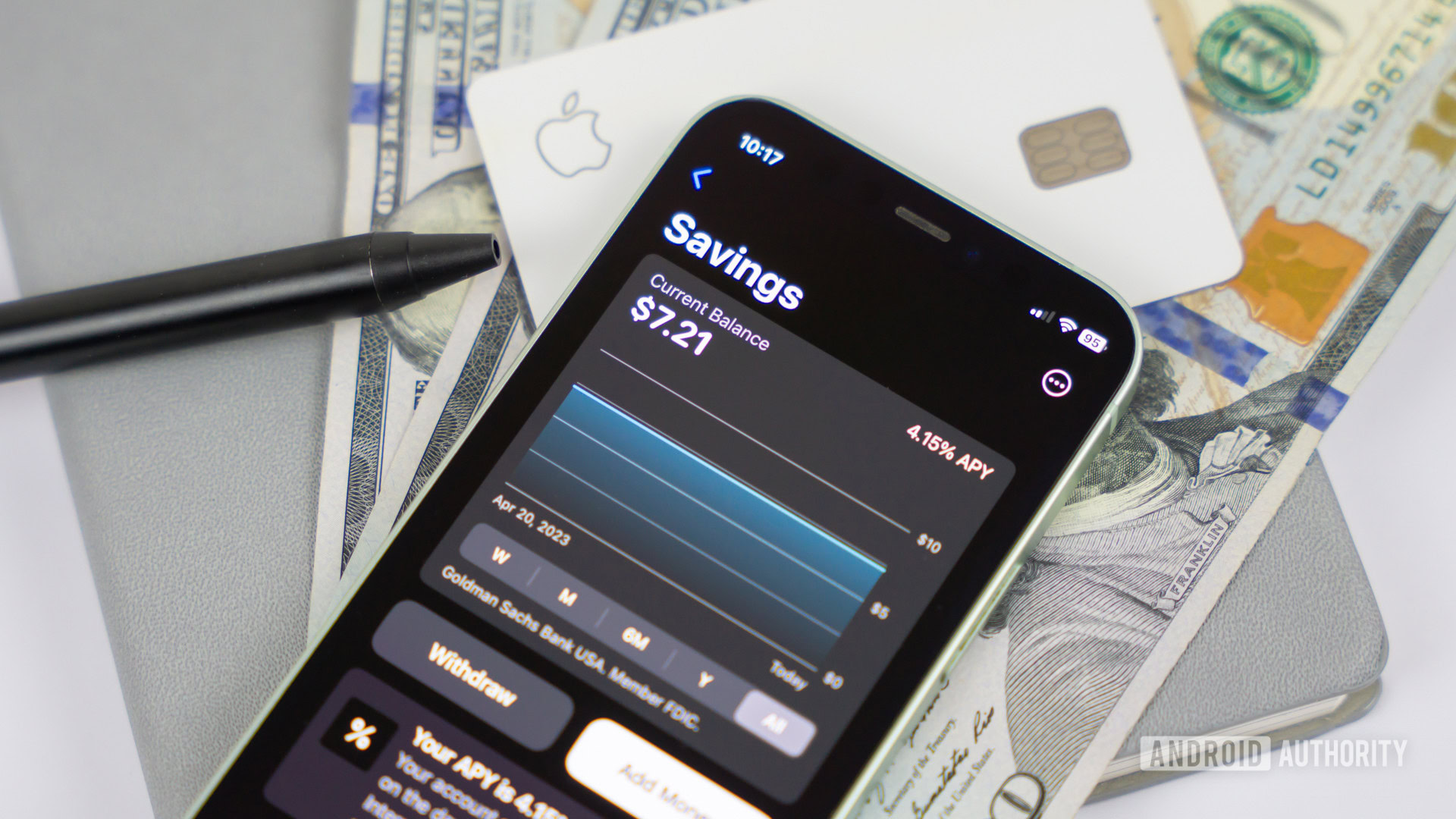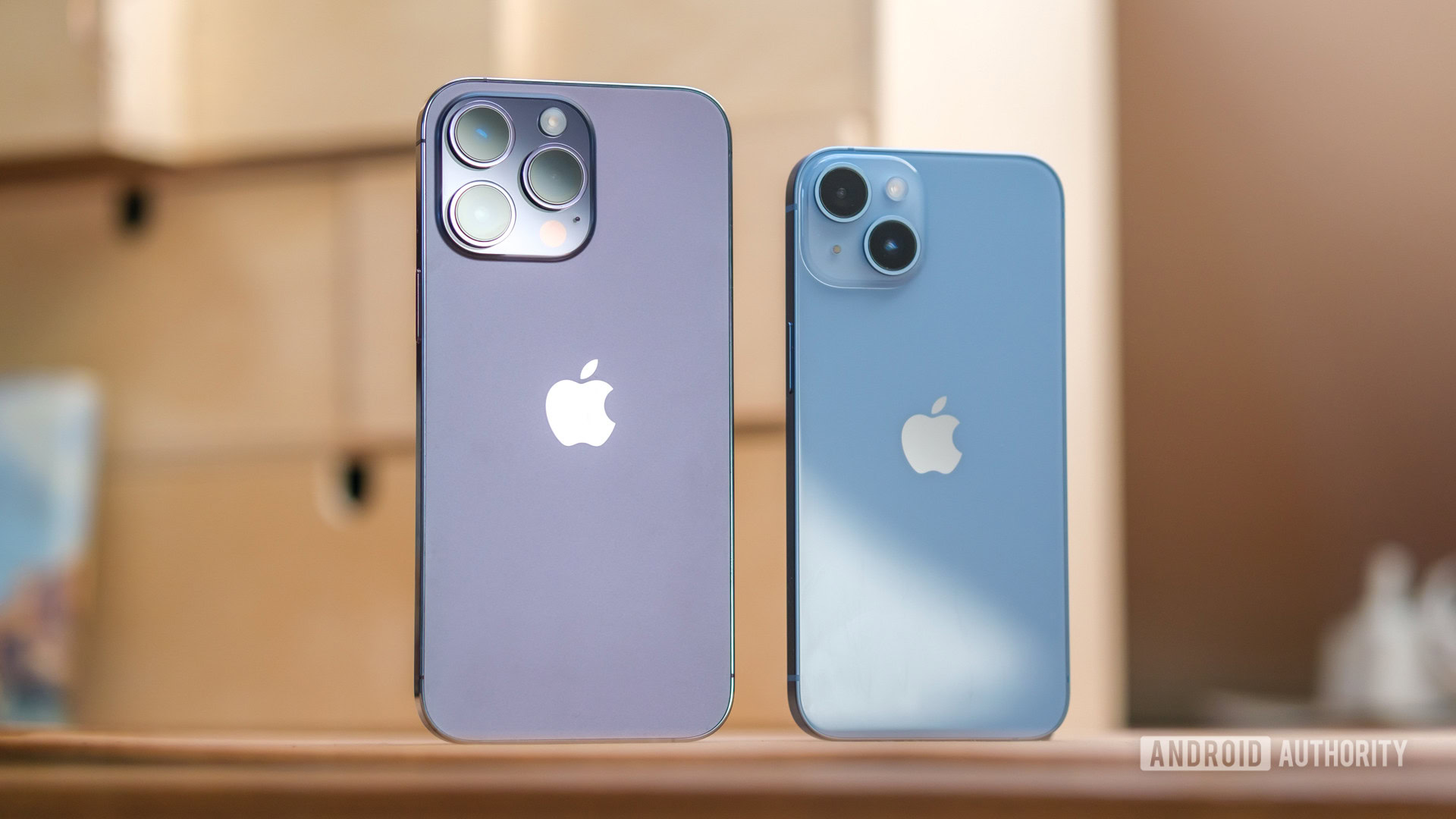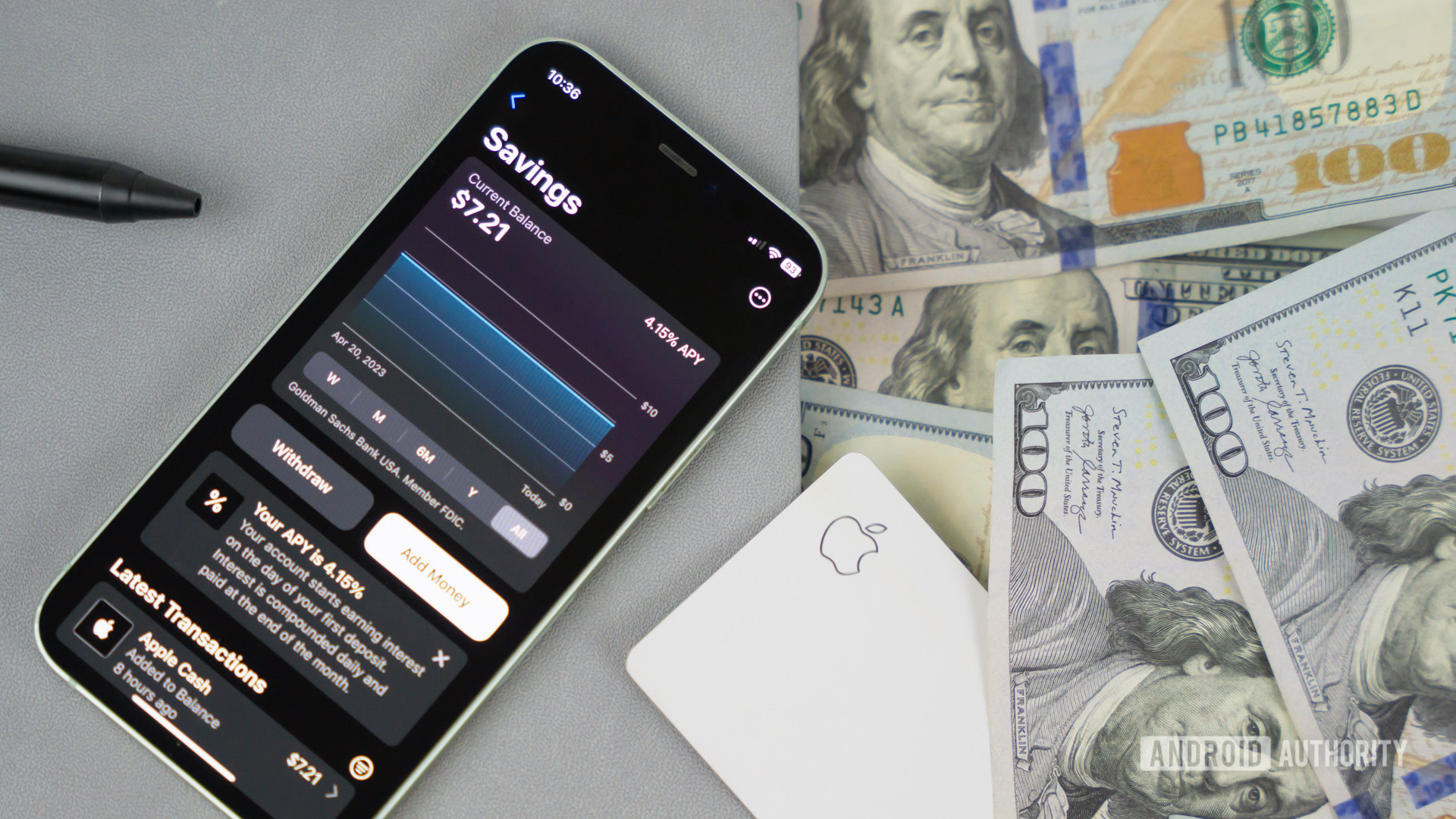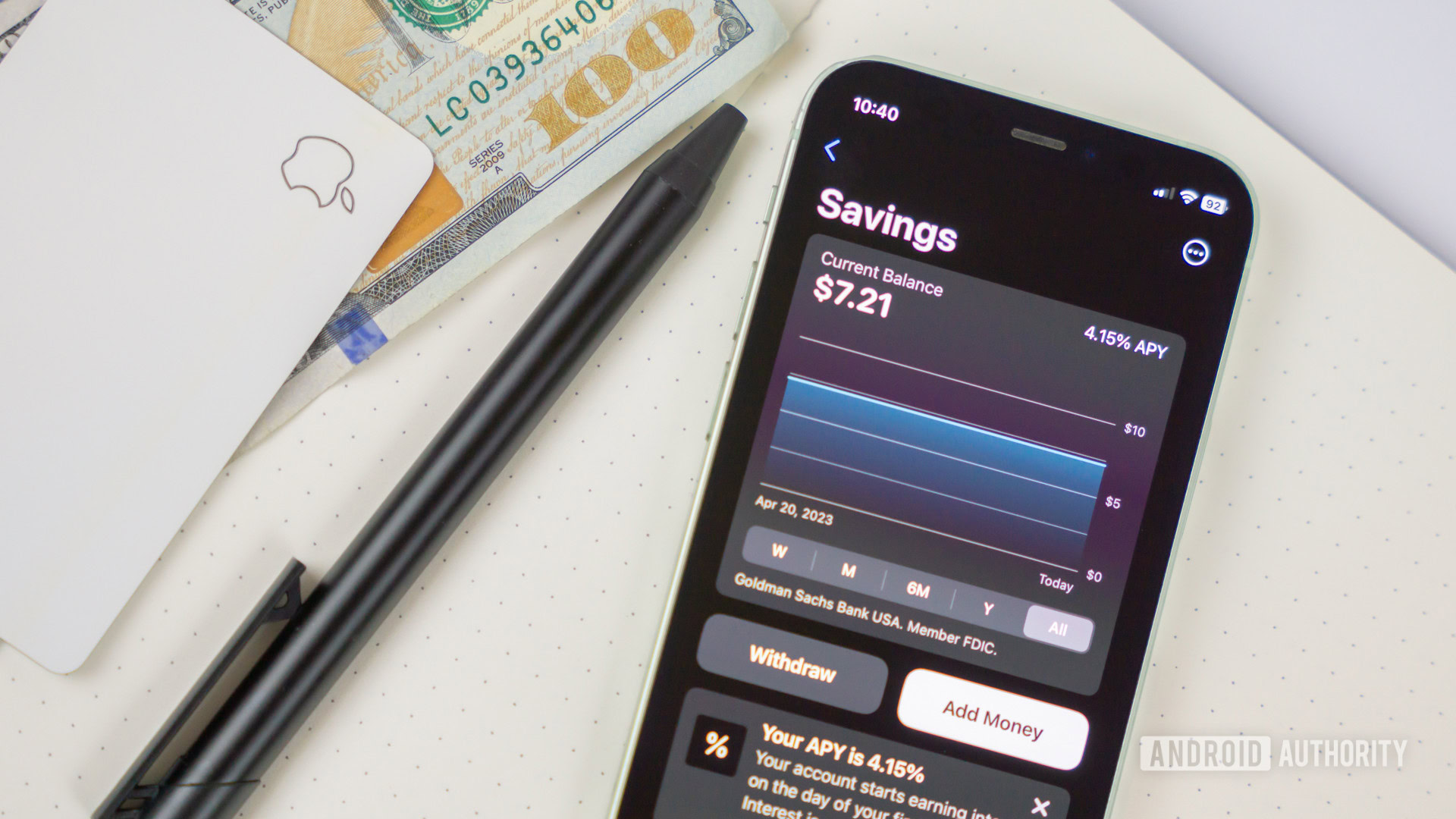Affiliate links on Android Authority may earn us a commission. Learn more.
Apple Card Savings account: Everything you need to know

Amid a recession, rampant inflation, and a possible banking crisis, finding the right investment options is essential. Most people want to park their money in a safe, liquid investment with as good an APY as possible. The Apple Card Savings account aims to be just that. Today, we’ll tell you all about the new high-yield savings account, who it’s for, who’s eligible, what you can get out of it, and everything else you need to know.
What is an Apple Card Savings account, and how does it work?

The Apple Card Savings account is a high-yield savings account available to Apple Card users. Apple partnered with investment bank Goldman Sachs to bring this financial service to market. The Apple Card and Apple Card Savings account are essentially linked, as you can’t have a Savings account without an Apple Card, and they are both offered by Goldman Sachs.
Apple proudly boasts some of its Savings account’s most exciting features. These include the lack of minimum balance requirements, minimum deposits, or associated fees. You can literally keep the balance at zero, and deposit as little as a penny.
It also offers a 4.15% APY, which Apple claimed was “more than 10 times the national average.” At the time of the Apple Card Savings account’s launch, this national average APY was about 0.24%. This number has gone up to 0.42% as of July 2023. Regardless, a 4.15% APY is still great! Of course, like any other high-yield savings account, this APY can change in the future, and Apple makes this very clear.
The Apple Card Savings account offers a 4.15% APY.
Goldman Sachs is an FDIC member. As the custodian of your Apple Card Savings account deposits, the cash is protected by FDIC insurance up to $250,000. This amount is also the deposit limit on the account, so your funds will be safe if anything goes wrong with Apple or Goldman Sachs.
The Apple Card Savings account is an Apple service through and through. You will need an Apple device with Apple Wallet in order to open the account, and you’ll also need an Apple Card. Once the account is opened, the account can stay open regardless of your device, but you won’t be able to manage your account efficiently. It will essentially just sit there collecting interest on the money you’ve already deposited. You can, however, call customer service at 1-877-255-5923 to get more information on your account, request paper statements, request check withdrawals, and a few other things.
Who is eligible for an Apple Card Savings account

Now that you have an idea of what the Apple Card Savings is all about, and you’ve decided you want in on that sweet interest earning, it’s important to take a step back and find out what the requirements for opening and holding an account are. There are actually quite a few, so let’s go over them.
You will need an Apple Card
The Apple Card Savings account honors its name strictly, at least for now. You must be an Apple Card owner or co-owner to get an Apple Card Savings account. Additionally, the card needs to be in good standing.
If you want to get an Apple card, you can apply for it here.
Apple Card Savings account age and country restrictions
For starters, you need to be 18 years of age to qualify for an Apple Card Savings account. Additionally, the investment tool is only available in the United States of America for now. Luckily, this isn’t limited to the mainland. People in “US Territories” like Puerto Rico and the United States Virgin Islands also qualify. It’s also available for people based in US military bases or embassies.
The Apple Card Savings account is only available in the United States.
And because this is a US-only service, you must have a Social Security Number or an Individual Taxpayer Identification Number. Additionally, you will need either an address in the US. A military base or embassy address works too.
The Apple Card Savings account is not for business use
This is another requirement that’s pretty well hidden in the terms of service. The Apple Card Savings account is meant for “natural persons.” This means it should only be used for “personal, family, or household purposes.” You can’t hold it for business purposes.
You will need an Apple mobile device

While Apple isn’t very clear about this, having an iOS or iPadOS device is essential to the experience. For starters, you will need an Apple device running iOS 16.4 or later, just to create the account, as well as Apple Wallet. Apple also requires that you set up two-factor authentication for your Apple ID.
After the Apple Card Savings account is opened, it’s possible to keep the account active without an Apple device, and let it collect interest long-term. However, managing it will become an annoying quest.
You'll need an iPhone or iPad to efficiently manage the Apple Card Savings account.
You won’t be able to easily add more money to it, withdraw funds electronically, or even look at your balance efficiently. As mentioned in the previous section, those without an iPhone or iPad will have to call customer service at 1-877-255-5923 to do things like get account information, check the balance, request paper statements, or make withdrawals in the form of a snail mail check.
In short, you’ll need either an iPhone or iPad to make the most out of the Apple Card Savings account. Or the Apple Card, for that matter. If you don’t have one, you can take a look at our lists of the best iPhones and best iPads.
What is the interest rate for the Apple Savings account?

As of the time of its launch, the Apple Card Savings account offers an interest rate of 4.15% APY. This is seen as a very good rate, especially for an account with no limitations. There are no fees, minimum balances, or minimum deposits, which is what truly makes it stand out. Not to mention the fact that it’s so easy to sign up for and manage, straight from a mobile device.
Of course, you need an Apple Card first, but this credit card is actually known as a relatively easy card to get. Even people with sub-prime credit scores and previous bankruptcies have been known to get it. Apple mentions anyone with at least a 660 score is considered “favorable for credit approval.”
Of course, some other high-yield savings accounts offer a similar, or sometimes even higher, APY. Most of them do implement minimum balances, minimum deposits, or managing fees, though. We’ll talk more about those in the next section.
How does the Apple Card Savings account compare to the competition?

Of course, the Apple Card Savings account isn’t the only player in the game. And while it’s one of the easiest to get for most Apple users, some might find other options to be better. Let’s take a look at some of the best competitors in the world of high-yield savings accounts to see how the Apple Card Savings account compares to them.
Just keep in mind these interest rates are based on what the banks had to offer at the same time as when the Apple Card Savings account launched. These numbers may change by the time you read this, so consider this a general guide to how the Apple alternative compares to others.
Apple Card Savings:
- APY: 4.15%
- FDIC insurance: Yes, up to $250,000
- Fees: None
- Minimum balance to earn interest: None
- Minimum deposit: None
Marcus by Goldman Sachs:
- APY: 4.30%
- FDIC insurance: Yes, up to $250,000
- Fees: None
- Minimum balance to earn interest: None
- Minimum deposit: None
Upgrade Premier Savings:
- APY: 4.81%
- FDIC insurance: Yes, up to $250,000
- Fees: None
- Minimum balance to earn interest: $1,000
- Minimum deposit: None
PNC High Yield Savings:
- APY: 4.65%
- FDIC insurance: Yes, up to $250,000
- Fees: None
- Minimum balance to earn interest: $1
- Minimum deposit: None
SoFi Checking and Savings:
- APY: 4.50% for balance in a savings account, 0.50% for balance in a checking account
- FDIC insurance: Yes, up to $2,000,000
- Fees: None
- Minimum balance to earn interest: None
- Minimum deposit: None
American Express High Yield Savings:
- APY: 4.25%
- FDIC insurance: Yes, at least $250,000
- Fees: None
- Minimum balance to earn interest: None
- Minimum deposit: None
Discover Online Savings:
- APY: 4.30%
- FDIC insurance: Yes, up to $250,000
- Fees: None
- Minimum balance to earn interest: None
- Minimum deposit: None
Bank of America Advantage Savings:
- APY: 0.01% to 0.04%, depending on your account’s tier
- FDIC insurance: Yes, up to $250,000
- Fees: $8 per month, unless you maintain a $500 balance or meet other requirements
- Minimum balance to earn interest: None right now
- Minimum deposit: $100 to open the account
As you can see, the Apple Card Savings account isn’t half bad compared to its major competitors. It leaves traditional banks like Bank of America in the dust, which we added to the comparison just to help you understand how bad things can get with the bigger banks.
Some competitors beat the Apple Card Savings account, but it leaves traditional banks in the dust.
Of course, plenty of competitors manage to beat the Apple Card Savings account. Upgrade, for example, gives you a lovely 4.81% APY, but there is a $1,000 minimum balance to earn interest. Of course, this might not be an issue for many of you. It might not be an ideal limitation if you’re just starting to save, though. In fact, a recent Bankrate report claims about 57% of Americans don’t have $1,000 for an emergency, so there is a high chance many won’t have the money to meet this minimum balance.
PNC Bank offers a nice alternative with a higher 4.65% APY, all the benefits Apple offers, and only a $1 minimum balance required to start earning interest. SoFi gives you a lower 4.50% APY, but it has the benefit of offering up to $2,000,000 in FDIC insurance, depending on where your money is allocated.
American Express and Discover are pretty good, too, offering 4.25% and 4.30% APY.
Are you signing up for an Apple Card Savings account?

The Apple Card Savings account may not be the best in the industry, but it’s close to the top contenders. And the fact that you can get it straight from your smartphone is an excellent incentive to start saving immediately. It’s a bit of a bummer that you need an Apple Card and an Apple device to get it, and some may even consider it a non-fair competitive practice, but such is the way of Apple.
All things considered, if you already have an Apple Card and have been thinking about getting a friendly high-yield savings account, this is undoubtedly a good one. And having your cashback rewards go straight to an interest-earning tool with the potential for compounding is always a good idea. Especially when it’s FDIC-insured and pretty much as safe as an investment can get. Of course, this is just an opinion, and we can’t give you financial advice.
If you do decide to get the Apple Card Savings account, though, we have a full tutorial on how to open and set up your Apple Card Savings account.
FAQs
No. The Apple Card Savings account is only available in the United States of America, as well as US Territories like Puerto Rico and the United States Virgin Islands. Military and government personnel stationed in US bases and embassies can also get it.
No. The Apple Card Savings accounts has no feed, minimum deposit rules, or minimum balance requirements. We’ve tested depositing a penny, and it works.
Yes. The Apple Card Savings account has passthrough FDIC insurance, thanks to the cash custodian being Goldman Sachs. Your deposits are covered up to $250,000.
The Apple Card Savings account limits you to $250,000 in deposits, which is the same as the maximum FDIC insurance coverage.
The Apple Card Savings account has no balance or deposit minimums in place. Your account starts at zero, and you can leave it that way if you wish. You can also deposit as little as a cent, which we’ve tested.
As of the time of its launch, the Apple Card Savings account offers a 4.15% APY. Just keep in mind this number may change, which is also the case with pretty much all high-yield savings account.
Sadly, no. The Apple Card and Apple Card Savings account can only be managed using the Apple Wallet app, which is only available for iOS and iPadOS.
You can transfer money to your Apple Card Savings account using a linked bank account. Additionally, you can move your Apple Cash money to it.
There is no official debit card transfer support, but remember, it’s possible to add money to your Apple Cash using a debit card, which you can then transfer to your Savings account.
The Apple Card Savings account supports withdrawing money to either your linked bank account or your Apple Cash balance.